Italian tiramisu is an ever-popular dessert that’s been knocking around for decades. A splash of Amaretto and orange play nicely with the strong coffee flavour in this twist on traditional tiramisu. It’s a no-bake and no-cook recipe that can be assembled in less than 30 minutes.
Try a creamy Baileys espresso martini or non-alcoholic caffè shakerato with this coffee dessert.
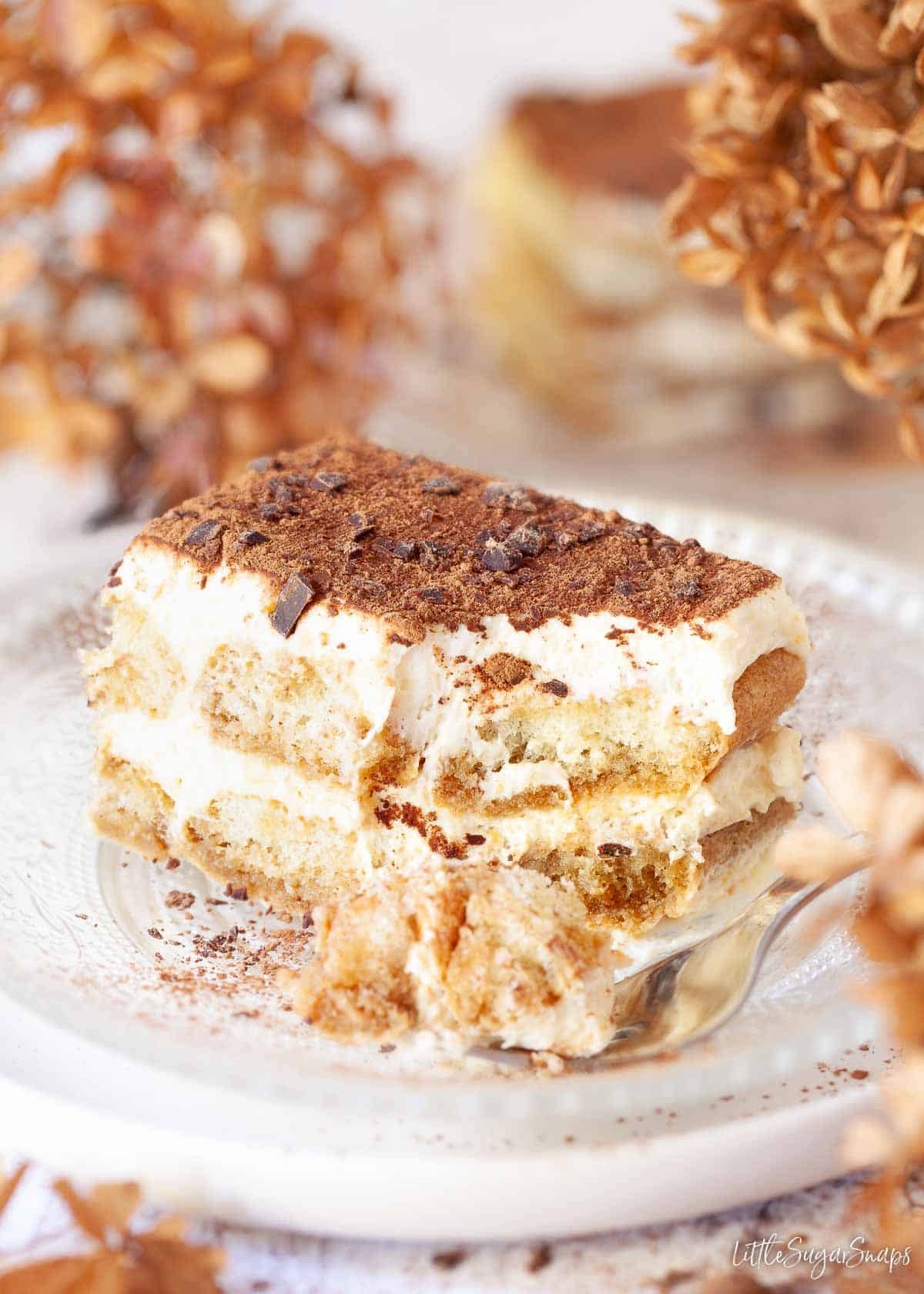
Want to Save This Recipe?
Why I love this recipe
- It’s no-bake.
- And it’s quick to assemble (around 20 minutes).
- It’s a great make ahead dessert.
- It’s creamy, full flavoured but not too sweet.
- This almost authentic Italian tiramisu recipe delivers a slightly different to expected flavour – the blend of coffee, Amaretto and orange is a winning combination.
My first slice of proper Italian tiramisu was enjoyed in Venice many moons ago. I’ve never forgotten this treat because it was the neatest looking piece of tiramisu I’d ever come across and the taste was spot on.
I’ve had a soft spot for this dessert ever since and today I’m sharing my version with you. Although this is a fairly authentic tiramisu recipe, I’ve meddled with the flavours slightly to bring you something a little different to the norm.
So if you are ready to liven up the traditional tiramisu recipe with a hint of amaretto liqueur and some zesty orange, read on. And if, like me, you are head over heels in love with anything related to this classic dessert try my recipes for pistachio tiramisu, Biscoff tiramisu, festive tiramisu cups and tiramisu pancakes recipe too.
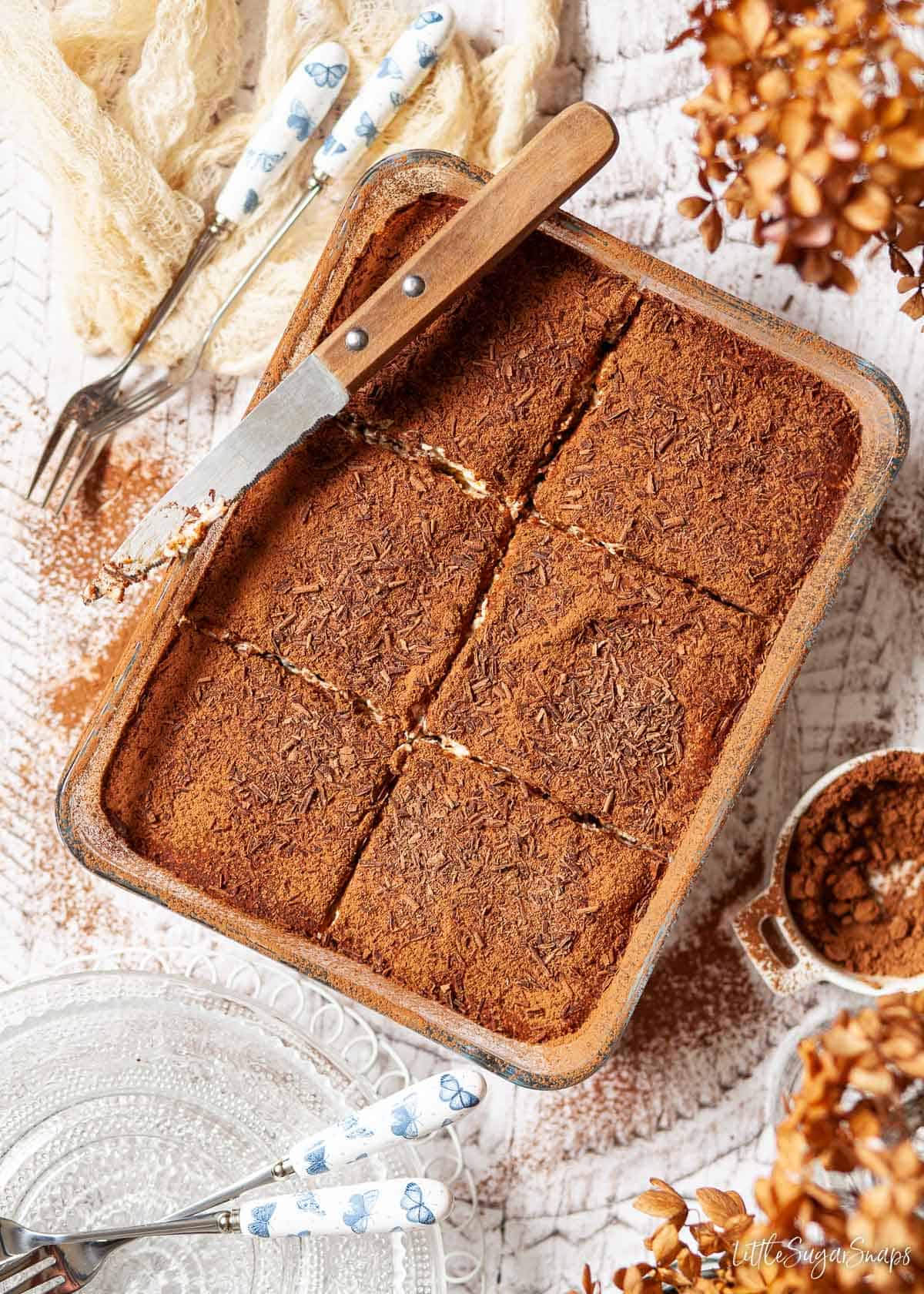
What is authentic tiramisu?
Tiramisu is a well known (and much-loved) Italian coffee-flavoured dessert. It translates to English as bring me up. And the strong espresso at the heart of this creation certainly does lift the spirits of weary diners.
Traditional tiramisu, also occasionally known as Tuscan trifle, is made by layering coffee-soaked ladyfingers (Savoiardi biscuits) with a light and airy mixture of eggs, sugar, and mascarpone cheese. The dessert is topped simply with a generous dusting of cocoa powder.
And that’s it. There’s no alcohol or additional flavours in a truly authentic tiramisu recipe. And it really is a treat – especially when enjoyed canalside in Venice (speaking from experience).
But of course, plenty of variations have materialised over the years. I’m adding my Amaretto tiramisu with orange to the long list of variations knocking around.
Ingredients notes
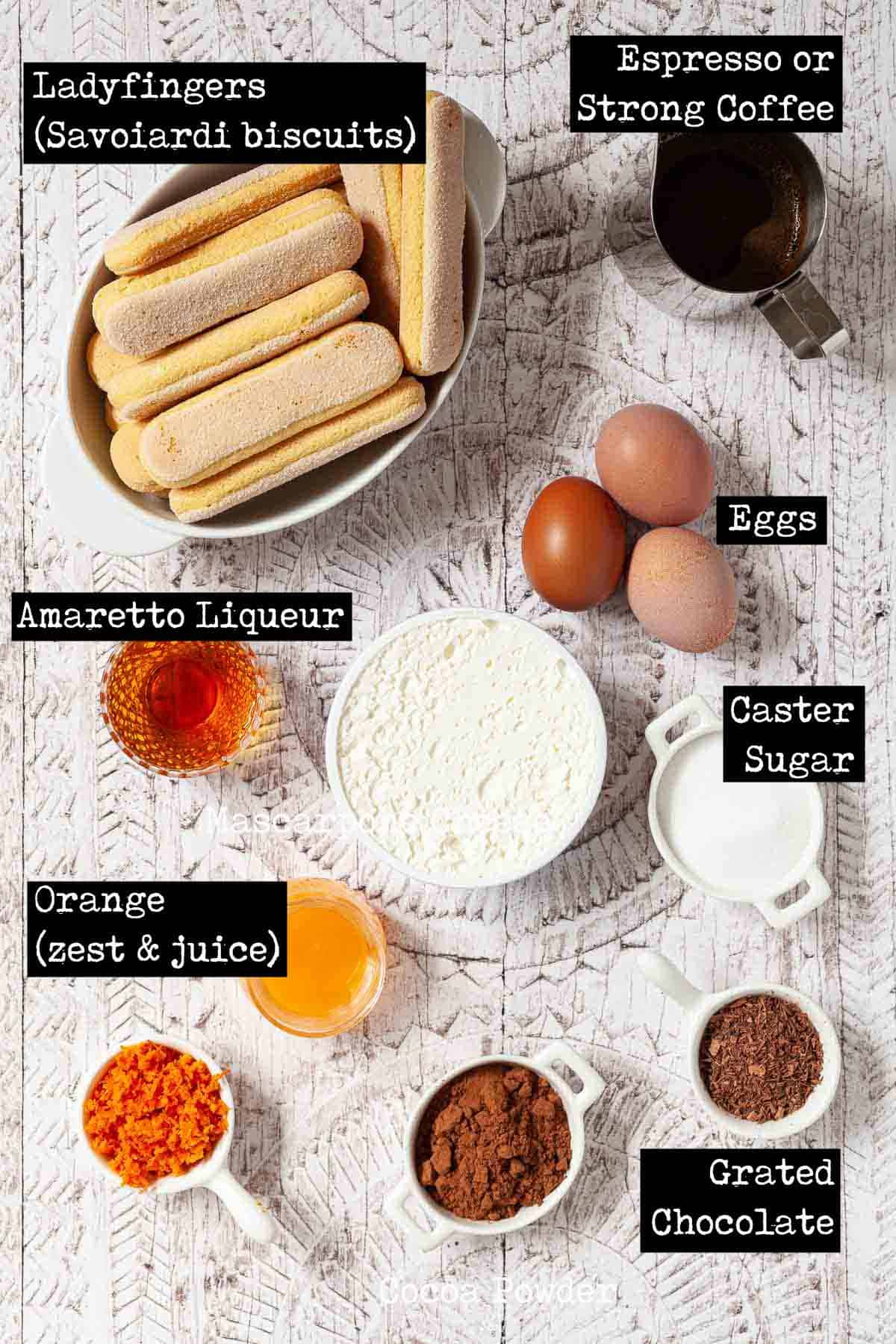
There are two star ingredients in this recipe – the mascarpone and the coffee.
Use good quality full-fat mascarpone cheese in this recipe and ensure it is fresh. Mascarpone can be a difficult ingredient to handle, so sticking to these guidelines is a good way to help reduce the risk of running into the problem of it splitting (covered in more detail further down).
Besides, Italian tiramisu is a sublimely perfect balance of creamy indulgence against a strong coffee background, so lower fat versions just don’t make for the best dessert in this instance.
Talking of the coffee, brew strong espresso if you can. Failing that, brew strong coffee using your favourite instant coffee granules. Decaff is fine in both cases.
I used store-bought Ladyfinger biscuits but if you fancy making your own I can only imagine it would take this dessert to another level again.
Use a quality brand of Amaretto – they are not all equal in terms of flavour or alcohol content. Having picked up a particularly unpleasant supermarket own-label version recently, I’ll never sway from Disaronna again – it’s the only one I’ll use in an Amaretto Sour. You can call me an Amaretto snob if you like.
If you prefer to keep things simple and make a more traditional tiramisu leave out the Amaretto, orange zest and juice. You’ll need to brew an extra 65ml of espresso for dipping the Ladyfingers into.
Step by step instructions
Full instructions and measurements are given in the printable recipe card at the end of this post.
1. Lay out enough ladyfingers in the bottom of the serving dish to cover the base entirely, chopping any up as necessary. Set aside the same amount of ladyfingers (chopped as required) for the second layer. Remove from the dish and set aside.
2. Whip the egg whites until fluffy and in a separate bowl whip the egg yolks and sugar until very thick, creamy and pale.
3. Mix in the orange zest then spoon the mascarpone into this mix and beat in until just combined (either by hand or using electric beater on a low speed). Take care not to overbeat as the mascarpone could curdle.
4. Gently fold the whipped egg whites in using a large metal spoon.

5. Mix the coffee, amaretto and orange juice together in a shallow bowl. Dip a ladyfinger into the coffee then flip over to coat the other side (dip for around 4 seconds in total). Place the ladyfinger in the base of your serving bowl. Continue with more ladyfingers until the base is covered.
6. Top with half of the mascarpone mixture then add another layer of ladyfingers, dipping them in the coffee mixture beforehand.
7. Spoon the remaining mascarpone mix over the top, smooth it out, cover and refrigerate for at least 6 hours but preferably overnight.

8. When ready to serve dredge in sifted cocoa powder.
9. A scattering of grated chocolate is optional.
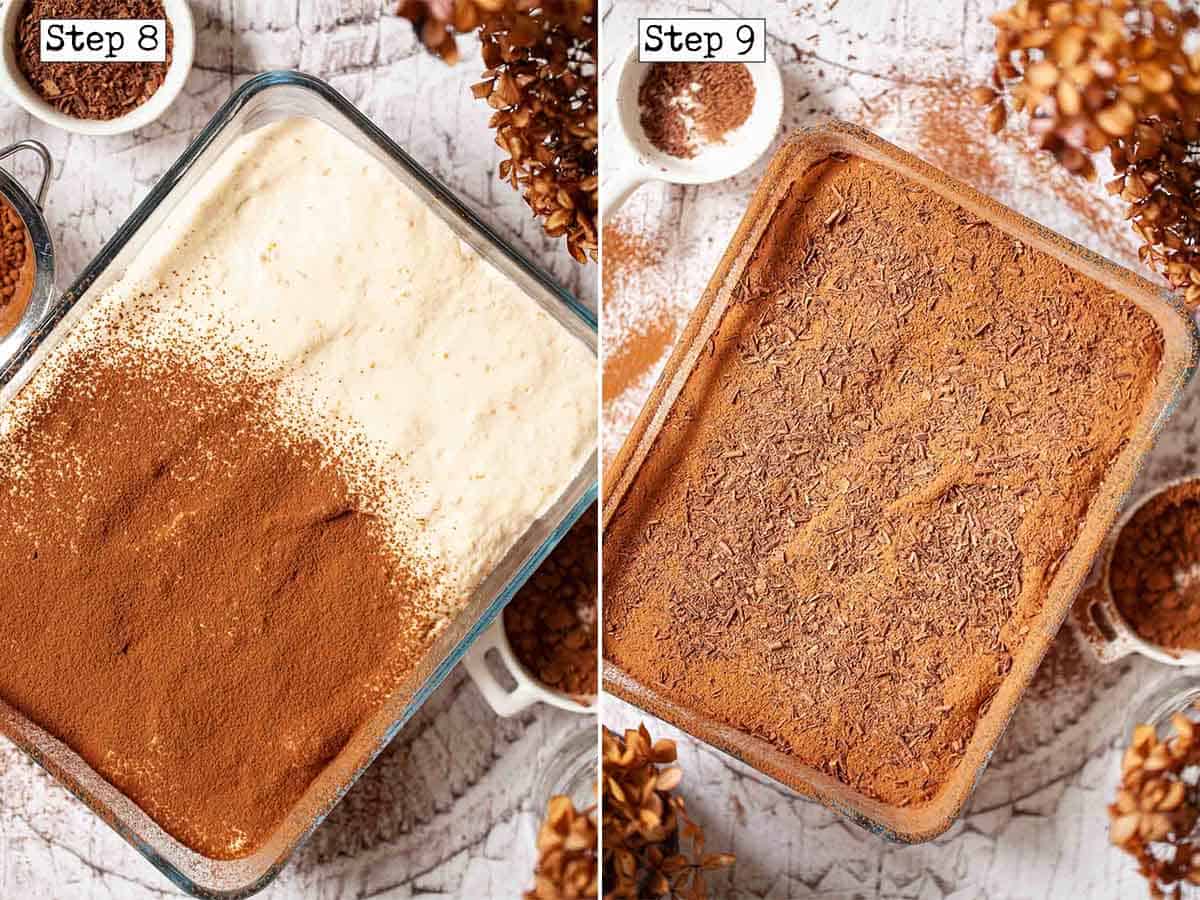
Expert tips
- Alternatively use a 6×6-inch baking tin (loose-bottomed and with deep sides) and use 3 layers of ladyfingers (spread ⅓ of the mascarpone mixture on top of each layer of ladyfingers).
- The exact number of ladyfingers needed will depend on the size of the bowl used to assemble the dessert in.
- It’s a good idea to lay out the ladyfingers in the base of the bowl before assembling the tiramisù. If some need cutting down to fit do it before assembly begins (a serrated knife is handy for cutting them).
- Don’t forget to prepare enough ladyfingers to make 2 full layers.
- The coffee needs to be brewed strong to carry a good flavour through the dessert. Use either:
- 45g espresso powder
- Or 4 heaped teaspoon of instant coffee granules
- This dessert does need to sit in the fridge to firm up for a minimum of 6 hours, but ideally, leaving it overnight is best. Whatever you do, don’t skimp on the time as the flavour and texture really do improve as it sits in the fridge to firm up.
- Use a knife to cut squares and use a fish slice to remove neat portions from the serving dish.
- For a more relaxed dinner, treat it as you would a trifle and simply scoop servings out using a large spoon – after all, it is sometimes known as Tuscan trifle.
- If you are unsure about your ability to present neat portions using the above method, assemble the dessert in a loose bottom baking tin lined around the edges with acetate. When ready to serve, remove the sides of the pan and the acetate then cut into portions and transfer to plates carefully using a cake server or fish slice.
- The recipe given is enough to fill a 6×8-inch oblong serving dish (around 2 inches deep). Use 2 layers of ladyfingers.
Frequently asked questions
This will happen if the ladyfingers are soaked for too long. Excess liquid held in the sponge fingers will leak into the dessert as it sits in the fridge turning it watery.
Soak the ladyfingers for a few seconds on each side (I usually count to two then flip them over and count to two again). If left to soak for too long then they may disintegrate when picked up as well as turning the dessert watery.
Sadly, mascarpone cheese is highly prone to splitting. You’ll know if it does as the contents of your bowl will look grainy, perhaps even reminiscent of cottage cheese.
Mascarpone can curdle if it is whipped with other ingredients of a higher temperature, so make sure both the cheese and eggs are well chilled before you start.
Older cheese is also more prone to splitting than fresh and similarly, low fat varieties are too. Always use quality, full-fat and fresh mascarpone for this recipe.
Even then there is still a risk of splitting – this ingredient is a notoriously tricky beast. The best way to reduce the risk of curdling is to beat the mascarpone either by hand or using electric beaters on a low-speed setting. Beat in 15 second bursts until just smooth. At this point stop beating.
In this, and many other authentic Italian tiramisu recipes the eggs are raw so it is vital to use eggs that are deemed safe to eat uncooked.
In the UK look for eggs with the British Lion mark – these eggs come from hens that have been vaccinated against salmonella. Elsewhere, opt for pasteurised eggs.
Recipes containing raw eggs, such as this one, are consumed at your own risk. If still unsure about using raw eggs you might be better off using a less authentic tiramisu recipe without eggs in it. This is perhaps advisable if serving to vulnerable diners such as pregnant women, very young children or very elderly people.
This version of traditional tiramisu can be stored in the fridge for up to 3 days (assuming the mascarpone is fresh when made). Always cover tightly to avoid fridge odours affecting it.
Leftovers can also be frozen for up to 3 months. Simply transfer to a suitable container, label and freeze. Defrost at room temperature for several hours or in the fridge overnight. It may be necessary to add a little more cocoa powder once defrosted to spruce up the presentation again.
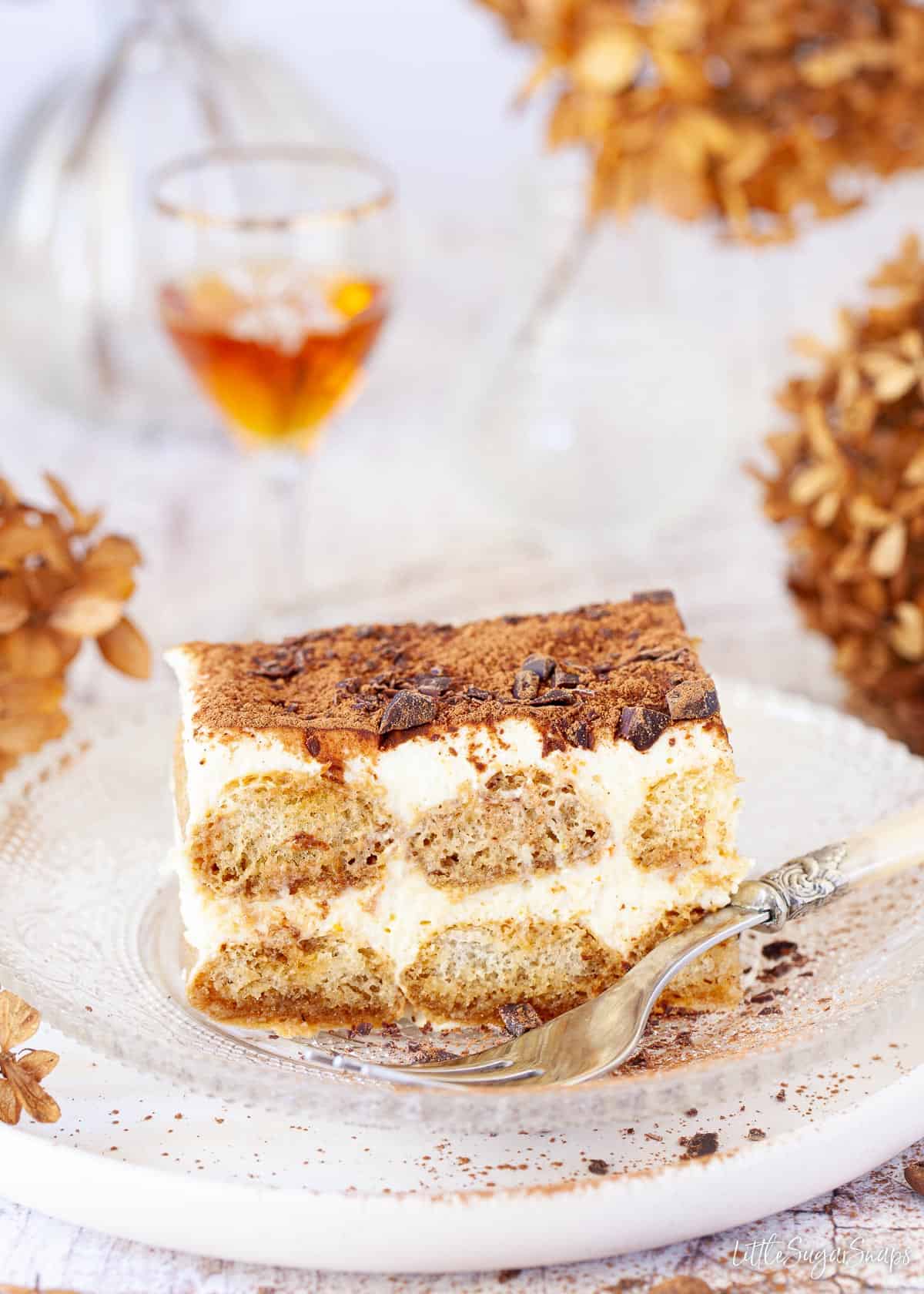
Variations
It’s easy to leave out the orange flavour and vary the alcohol in this Italian tiramisu recipe. Try Marsala wine (quite a classic), Baileys Irish Cream or a coffee liqueur such as Kahlua or Galliano Ristretto.
But there’s also plenty of other variations of this much-loved dessert floating around too:
More Italy-inspired recipes
If you have tried this variation on traditional tiramisu please give the recipe a rating or comment. I love to hear how you get along with my creations.
Stay in touch: sign up to receive LittleSugarSnaps newsletters to hear when new recipes are published. Or follow me on social media:
📖 Recipe
Want to Save This Recipe?

Italian Tiramisu with Amaretto and Orange
Equipment
- A 6×8-inch serving bowl (preferably straightsided). A 6×6 inch baking tin (loose-bottomed with deep sides) can alternatively be used – see notes for further details
Ingredients
- 3 Small eggs free-range (or 2 large)
- 2 tablespoon Caster sugar
- 250 g Mascarpone cheese full-fat
- 125 ml Espresso coffee see notes
- 1 Orange zest and 4 teaspoon juice
- 3 tablespoon Amaretto liqueur good quality
- 16-20 Ladyfingers A 200g packet will be plenty
- 1½ tablespoon Cocoa powder
- 1 tablespoon Chocolate grated
Instructions
- Lay out enough ladyfingers in the bottom of the serving dish to cover the base entirely, chopping any up as necessary. Set aside the same amount of ladyfingers (chopped as required) for the second layer. Remove from the dish and set aside
- Whip the egg whites until fluffy
- Use the same beaters to whip the egg yolks and sugar until very thick, creamy and pale – around 3-4 minutes. They are whipped sufficiently when a trail remains for a few seconds after the mixture falls off the whisk (this is the ribbon stage)
- Stir the orange zest through
- Stir the mascrapone to loosen it, then add to the egg yolk mixture and beat in until just combined (either by hand or using electric beater on a low speed). Take care not to overbeat as the mascarpone could curdle. If using electric beaters, try beating in 15 second bursts to ensure is is beaten just sufficiently
- Gently fold the whipped egg white in using a large metal spoon
- Mix the coffee, amaretto and orange juice together in a shallow bowl then dip a ladyfinger into the coffee then flip over to coat the other side (dip for around 4 seconds in total)
- Place the ladyfinger in the base of your serving bowl. Continue with more ladyfingers until the base is covered
- Top with half of the mascarpone mixture
- Add another layer of ladyfingers, dipping them in the coffee mixture as before
- Spoon the remaining mascarpone mix over the top, smooth it out, cover and refrigerate for at least 6 hours but preferably overnight
- When ready to serve dredge in sifted cocoa powder and (optional) grated chocolate
Notes
- The exact number of ladyfingers needed will depend on the size of the bowl used to assemble the dessert in
- It’s a good idea to lay out the ladyfingers in the base of the bowl before assembling the tiramisù. If some need cutting down to fit do it before assembly begins (a serrated knife is handy for cutting them)
- Don’t forget to prepare enough ladyfingers to make 2 full layers
- The coffee needs to be brewed strong to carry a good flavour through the dessert. Use either:
- 45g espresso powder
- Or 4 heaped teaspoon of instant coffee granules
- This dessert does need to sit in the fridge to firm up for a minimum of 6 hours, but ideally, leaving it overnight is best. Whatever you do, don’t skimp on the time as the flavour and texture really do improve as it sits in the fridge to firm up
- Use a knife to cut squares and use a fish slice to remove neat portions from the serving dish
- For a more relaxed dinner, treat it as you would a trifle and simply scoop servings out using a large spoon – after all, it is sometimes known as Tuscan trifle
- If you are unsure about your ability to present neat portions using the above method, assemble the dessert in a loose bottom baking tin lined around the edges with acetate. When ready to serve, remove the sides of the pan and the acetate then cut into portions and transfer to plates carefully using a cake server or fish slice
- The recipe given is enough to fill a 6×8-inch oblong serving dish (around 2 inches deep). Use 2 layers of ladyfingers
- Alternatively use a 6×6-inch baking tin (loose-bottomed and with deep sides) and use 3 layers of ladyfingers (spread ⅓ of the mascarpone mixture on top of each layer of ladyfingers)
- This tiramisu can be stored in the fridge for up to 3 days (assuming the mascarpone is fresh when made). Always cover tightly to avoid fridge odours affecting it
- Leftovers can also be frozen for up to 3 months. Simply transfer to a suitable container, label and freeze. Defrost at room temperature for several hours or in the fridge overnight. It may be necessary to add a little more cocoa powder once defrosted to spruce up the presentation again








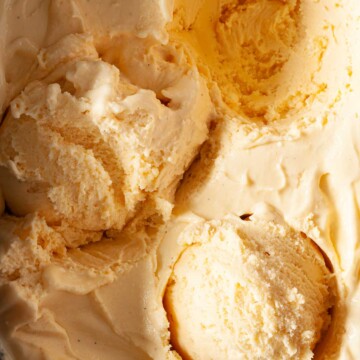
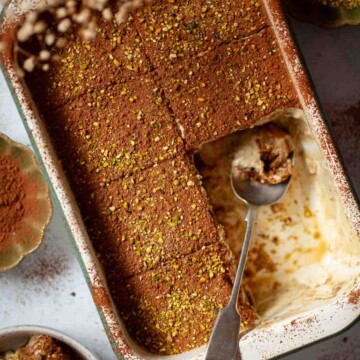


Ripon hassan
You have made the recipe and described everything so nicely that really helped me. I am sure to visit again for more of such delicious recipes in future too.
Jane Saunders
Thankyou Ripon. I really appreciate your feedback – all the process shots are a labour of love for the recipe. I really hope you enjoyed the tiramisu!